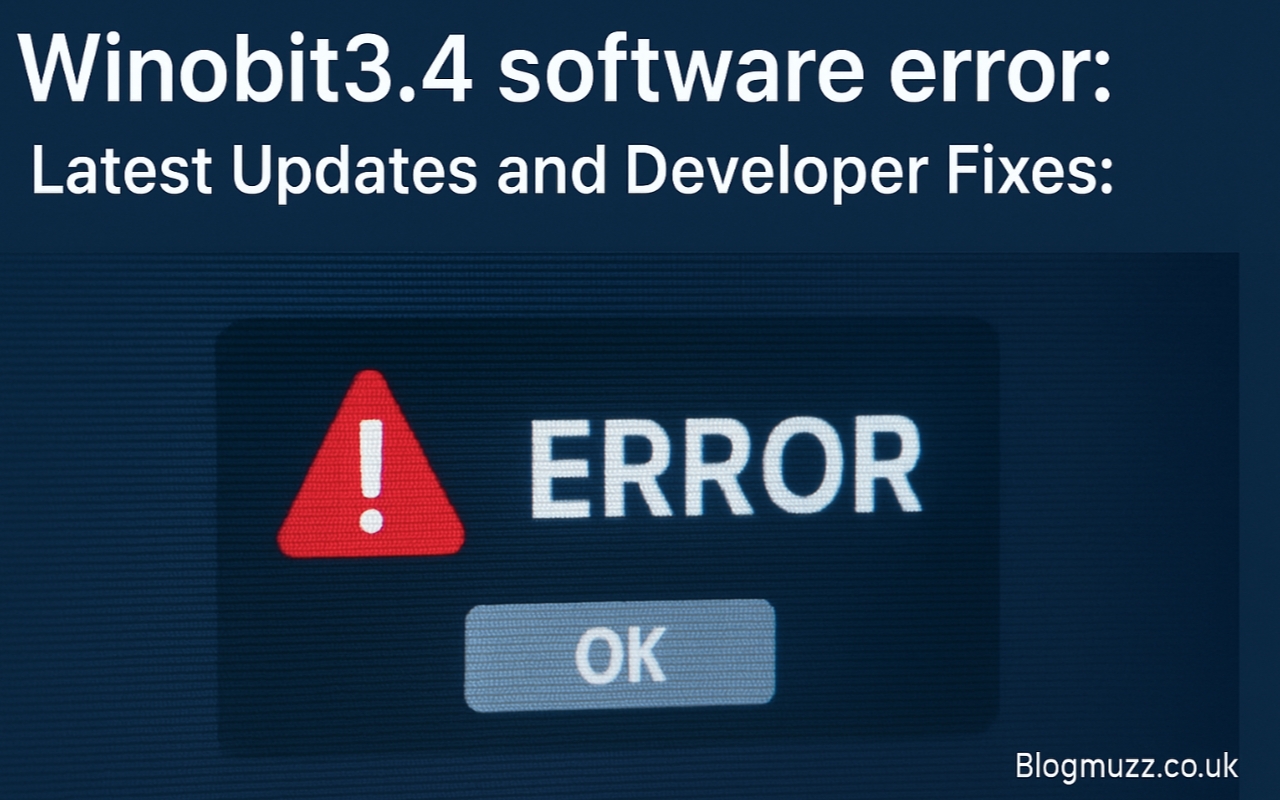Software reliability is the foundation of modern digital productivity. When a program encounters errors, it not only disrupts workflow but can also cause data loss, frustration, and downtime. In recent months, many users have reported issues with Winobit3.4 software error, leading to unexpected crashes, slow performance, and functionality failures. This comprehensive guide explores the causes of the Winobit3.4 software error, its latest updates, and the fixes provided by developers and experts.
Understanding the Winobit3.4 Software Error
The Winobit3.4 software error refers to a set of system or application malfunctions within the Winobit version 3.4 environment. Winobit, known for its powerful optimization and system diagnostic tools, has generally maintained a strong reputation for improving PC performance. However, the 3.4 release introduced new features that have, in some cases, conflicted with existing system configurations or third-party applications.
Users have reported diverse manifestations of the issue — from installation failures to runtime crashes and incomplete updates. Some have even noticed their system utilities or drivers behaving inconsistently after the Winobit3.4 update, suggesting deeper integration conflicts between the software and Windows frameworks.
Common Symptoms of the Winobit3.4 Software Error
Understanding how the error appears helps users identify the problem before it worsens. While not every user experiences the same pattern, the following are the most frequent signs linked to the Winobit3.4 software error:
- Startup Failures: Winobit3.4 fails to launch properly or freezes during startup.
- Frequent Crashes: The software unexpectedly closes during optimization or system scanning.
- Error Messages: Users receive generic Windows pop-ups such as “Winobit.exe has stopped working” or “Runtime Error in module Winobit3.4.”
- Slow System Response: After the update, some systems exhibit lagging performance or delayed response times.
- Registry Conflicts: Incorrect registry entries created by Winobit3.4 can lead to deeper system instability.
- Update Loop Errors: Some users find themselves stuck in an endless update or patch installation cycle.
Recognizing these signs early allows users to take preventive action — from backing up files to contacting support before a system crash leads to data corruption.
Root Causes Behind the Winobit3.4 Software Error
The root causes of the Winobit3.4 software error vary depending on the user’s environment, but several recurring factors have been identified by both the developer team and independent technical analysts:
1. Incomplete Installation or Update
Interrupted downloads or incomplete installations are a common source of the problem. If the Winobit3.4 setup process is stopped mid-way, missing system files can trigger runtime errors.
2. Compatibility Conflicts
The 3.4 version introduced enhanced performance modules that rely on specific versions of Microsoft Visual C++ redistributables and .NET frameworks. Systems lacking these dependencies often report startup failures or performance anomalies.
3. Corrupted System Files
Malware, sudden power loss, or improper shutdowns can corrupt files required by Winobit3.4. These corrupted files cause the application to malfunction or display random error codes.
4. Registry Misconfigurations
Winobit’s optimization features modify Windows registry entries. In certain cases, the program inadvertently alters or removes critical registry values, leading to cascading errors.
5. Conflicts with Antivirus or Firewall
Security software can sometimes flag Winobit processes as suspicious, blocking their operation. This false positive results in failed scans or incomplete optimization cycles.
6. Bugs in the Software Code
Like many complex utilities, Winobit3.4 has its share of internal bugs. Some users identified memory leaks, thread deadlocks, and permission issues that require patch-level fixes from developers.
By identifying these causes, users and IT teams can take more targeted corrective actions instead of general troubleshooting that may not resolve the issue.
Impact of Winobit3.4 Software Error on System Performance
The Winobit3.4 software error doesn’t just affect the program itself—it can influence the entire Windows environment. For many users, the malfunctioning software consumes excessive CPU or RAM resources, reducing overall system speed. In severe cases, the program triggers Windows error reporting processes that loop continuously, preventing other applications from running smoothly.
A few users also reported that their system registry became cluttered with invalid entries, leading to boot delays and sluggish performance. In enterprise setups, where Winobit is deployed across multiple machines, the error can amplify network-wide inefficiencies, increasing downtime and maintenance costs.
Ultimately, ignoring the problem can degrade system reliability, increase repair costs, and risk permanent data loss.
Latest Updates Released by the Developers
To address the growing number of complaints, the Winobit development team has rolled out several patches and updates designed to stabilize version 3.4. The latest update, released in October 2025, introduced critical bug fixes, improved compatibility with Windows 11, and enhanced system diagnostic algorithms.
Key Improvements Include:
- Stability Enhancements: Memory management routines have been restructured to prevent leaks and random crashes.
- Registry Safety: The latest patch limits the scope of registry modifications, reducing the risk of accidental corruption.
- Faster Launch Time: Optimization processes now initialize up to 25% faster, even on older hardware.
- Improved Error Reporting: A new diagnostic log helps developers track error sources more effectively.
- Patch Auto-Recovery: In case of failed updates, Winobit now auto-restores to the previous stable version.
The developers have acknowledged the earlier stability issues and have encouraged users to download the official patch from the verified Winobit portal rather than third-party sites. They also emphasized enabling automatic updates to prevent recurrence of the Winobit3.4 software error after each system patch.
Step-by-Step Solutions to Fix the Winobit3.4 Software Error
While official patches are the safest route, users can take several manual troubleshooting steps to resolve issues when updates fail or errors persist. Below is a practical guide:
Step 1: Reinstall the Application
Uninstall Winobit3.4 completely through the Windows Control Panel. After that, delete any remaining files in:
C:\Program Files\Winobit\
and
C:\Users\<YourName>\AppData\Local\Winobit\
Then reinstall the latest stable version directly from the developer’s website.
Step 2: Update Windows Components
Ensure your Windows system is fully updated. Missing Visual C++ or .NET Framework components can prevent Winobit from functioning correctly. Use Windows Update to install all available patches.
Step 3: Disable Antivirus Temporarily
If your antivirus software is blocking Winobit, temporarily disable real-time protection during installation or runtime. Re-enable it afterward once you verify that Winobit runs without conflict.
Step 4: Repair Registry Issues
If you suspect registry corruption, use the built-in Windows tool:
sfc /scannow
This command checks and repairs missing or damaged system files that may interfere with Winobit.
Step 5: Run in Compatibility Mode
Right-click the Winobit executable file, select Properties → Compatibility, and run it under a previous Windows version (for example, Windows 10) to bypass framework conflicts.
Step 6: Contact Developer Support
If none of the above steps work, submit your diagnostic log to the Winobit support team. They can provide a customized patch or guide specific to your error code.
Following these structured solutions minimizes the risk of repeated crashes and helps restore Winobit3.4’s intended performance benefits.
Developer Statements and Official Fix Notes
The development team released a series of statements confirming awareness of the Winobit3.4 software error. According to the November 2025 patch notes, the issue originated from “a conflict between the system optimization scheduler and certain Windows kernel tasks.” Developers redesigned these modules to ensure smoother communication between processes.
They also introduced a self-healing mechanism, where Winobit automatically verifies the integrity of its own files upon startup. If corruption is detected, the program will re-download the affected components instead of relying on manual reinstalls. This marks a major improvement in the user experience and reflects the developers’ commitment to long-term stability.
The company further announced that future releases will undergo extended beta testing periods to catch hidden bugs before public rollout. A cloud-based error monitoring dashboard will soon be integrated, allowing real-time diagnostics and faster response to user reports.
Preventive Measures to Avoid Future Winobit3.4 Errors
Preventing future errors is as important as fixing current ones. Here are practical recommendations to keep Winobit3.4 running smoothly:
- Keep Software Updated: Always enable automatic updates to receive the latest bug fixes.
- Avoid Third-Party Cracks or Mods: Non-official versions can contain malicious scripts or outdated modules.
- Maintain Clean System Health: Use reputable antivirus programs and avoid unnecessary background apps that conflict with Winobit.
- Back Up Registry and System Files: Before making changes, create a restore point to recover easily from unexpected issues.
- Run Regular Maintenance: Schedule system scans and disk checks to detect potential conflicts early.
- Monitor System Logs: Use Windows Event Viewer to track recurring Winobit warnings or errors.
Following these best practices ensures not only a stable Winobit experience but also better overall Windows performance.
Community Feedback and User Experiences
Community responses to the Winobit3.4 software error have been mixed. On various tech forums and social media platforms, early adopters expressed frustration with the instability of the initial 3.4 release. However, after the latest developer patches, many users reported significant improvement in system reliability.
One power user noted, “After installing the October patch, Winobit runs faster and no longer crashes during deep scans.” Another reported that the update “finally fixed the registry cleaning bug that kept freezing my laptop.”
Still, a minority of users continue to face performance hiccups, particularly on older systems. Developers are collecting these reports to refine the compatibility matrix for the next release, Winobit 3.5, expected in early 2026.
This ongoing dialogue between users and developers highlights how community engagement can accelerate problem resolution and enhance software quality.
Expert Recommendations for IT Professionals
For IT administrators managing Winobit across multiple workstations, efficient problem management requires a structured approach:
- Centralize Patch Deployment: Use network management tools to ensure all installations are running the same, verified version.
- Automate Diagnostics: Implement scripts that check for Winobit service status and report anomalies before they impact users.
- Maintain Change Logs: Record each update and configuration change to trace the source of future issues quickly.
- Educate End Users: Provide short tutorials on recognizing early warning signs of the Winobit3.4 software error.
- Test Updates in Sandboxed Environments: Always validate new patches on isolated machines before global rollout.
These strategies reduce downtime and ensure the organization maintains consistent system performance across all devices.
Future Outlook for Winobit Software
The developers behind Winobit have assured users that the lessons learned from version 3.4’s instability are shaping a more reliable and efficient future release. Winobit 3.5 is expected to feature:
- Improved multi-core optimization
- Enhanced AI-driven diagnostics
- Modular architecture for faster updates
- Reduced memory consumption
- Expanded compatibility with Linux and macOS (under development)
If these promised features materialize, Winobit could reclaim its position as a leading optimization utility. However, sustained transparency and continuous patching will remain essential to maintain user trust after the Winobit3.4 software error experience.
Conclusion
The Winobit3.4 software error serves as a reminder that even the most well-engineered software can encounter issues when interacting with diverse system environments. Fortunately, the developers’ quick response, consistent updates, and transparent communication have already resolved most known problems.
For users still experiencing errors, applying the latest patches, maintaining clean system configurations, and following proper troubleshooting steps can restore optimal functionality. Looking ahead, the Winobit development team’s proactive approach and commitment to user feedback suggest a brighter, more stable future for all Winobit versions.
In the fast-moving world of software development, continuous improvement is key. With every update, Winobit demonstrates that no error is permanent — only an opportunity to build stronger, more resilient technology.



